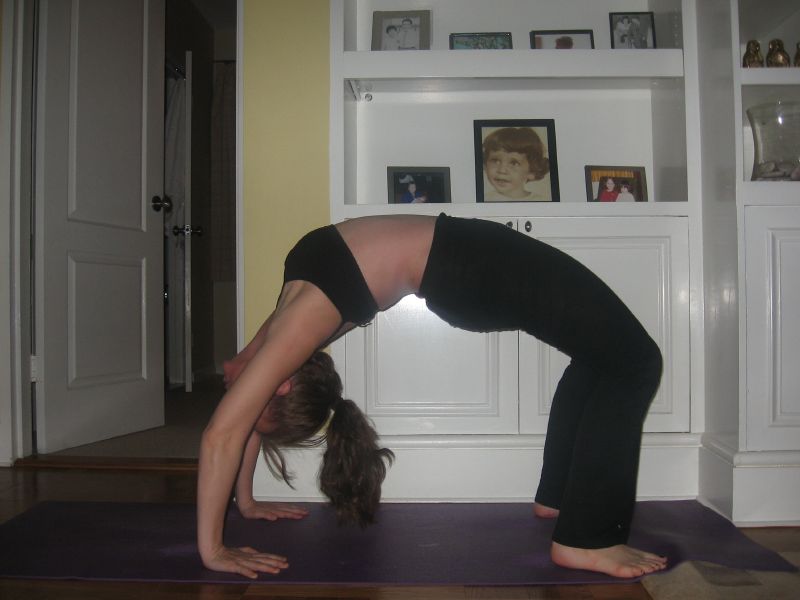And now, the teaching on yoga begins
Instead of delving into an In Touch or People weekly while waiting for Adam at Tae Kwon Do today, I decided to delve into Patanjali's Yoga Sutras. I do this now and then, and like the Torah in the Jewish religion, the Sutras are meant to be read over and over again, in order, and preferably out loud (think chanting). While chanting wasn't an option the Dojo, reading certainly was, and so I lotused my legs, took a deep breath and delved away.
About halfway through the commentary on Chapter 1, Verse 2 (Yoga Chitta Vrtti Nirodha, i.e. Yoga is the stilling of the fluctuations of the mind), I realized that this "delving" I'm doing is not something that can be done in the typical rush-rush, all or nothing Yoga Chickie fashion...which is to say that the Yoga Sutras just beg to be savored and taken no more than one at a time, maybe two or three at the most (depending on which of the sutras you're reading).
And so, since I seem to be running out of things to say about Mari C (finally! like a relationship with a lover, you know it's good when you don't really have anything to decipher, analyze or pick apart)...I figure that I might as well record my thoughts on the Sutras I'm reading. Hopefully, I can get into the habit of doing this on a regular basis, lest I find myself slipping into BADD mode (Blogger ADD).
So, to begin....
Chapter 1, Verse 1: At-ha Yoganushasanam....And now the teaching on yoga begins.
What has always struck me most about Chapter 1, Verse 1 is the way it is phrased: AND now the teaching on yoga begins. It seems to suggest that we are not starting from the beginning, but from a place in an endless circle. That is the way we are taught to read the Sutras, that is the way yoga is to be taught, and that is the way yoga is to be practiced. And that is the nature of the Eight Limbs....rather than being a liner progression, the eight limbs together comprise a gestalt, each one a puzzle piece in a whole picture.
Although in Ashtanga, we are taught Asana first and before we are taught any of the other eight limbs, in truth, each limb is necessary for each other limb of the yoga tree. Basic pranayama (think: ujayii) is necessary for asana practice. Asana leads to a meditative state when done properly. The Yamas and the Niyamas (the ethical principles and rules for living) provide a roadmap for a calmer, more peaceful life, which makes it easier to get to the mat and to commit to a practice. The three meditative limbs require a certain level of adeptness, they build on all of the other limbs and they enhance our experience of all of the other limbs.
In other (non-Ashtanga) yoga traditions, all eight limbs are taught together. For example, all classes at Om Yoga, from basics through "super advanced" (yes, they do have a "super advanced" class, called "Advanced 2") are supposed to include pranayama and meditation, along with asana. And many Om classes will bring in the Yamas and the Niyamas into the day's theme (for example, "Ahimsa and Satya in Asana Practice, which ends up meaning "how not to harm your body and how not to lie to yourself about your body's abilities vis a vis your asana practice").
Jivamukti also includes pranayama (usually in the form of kappalabhati breathing), as does, dare I say it, Bikram (I am sure there are those who will object to Jivamukti and Bikram being uttered in the same sentence, but whatever, it's just words). Bikram calls itself a "moving meditation", and many Jivamukti classes end with a formal meditation (Inhale "Let", Exhale "Go"). Jivamukti includes teachings of Ahimsa ("Cats are people too") and Tapas (heat), as I recall from the days that I used to practice there all the time, if not most of the other Yamas and Niyamas.
And thus, out of the barest thread of one sutra, "At-ha Yoganushasanam", is woven what can only be a very incomplete tapestry. As always, your thoughts are welcome additions...
YC








1 comment:
My favorite interpretation of the Yoga Sutras is BKS's Light on the Yoga Sutras of Patanjali. His interpretaton of 1.1 atha yoganusasanam is
With prayers for divine blessings, now begins an exposition of the sacred art of yoga.
It seems that this is merely an introduction of sorts, a putting down of a complex and integrated practice into words. Patanjali's gift for us to explore and experience at a deeper philosophical level.
As far as the 8 limbs of yoga go I think that 11.1 is more of a discussion about what you are talking about. Tapa svadyaya ishvarapranidhani kriyayogah, which encourages to use al the 8 limbs to find union. I don't believe that one can practice yoga in a serious manner with out all the limbs coming into play eventually. We all practice the eight limbs in a fashion everyday, practice just helps to cement them into our lives.
Post a Comment